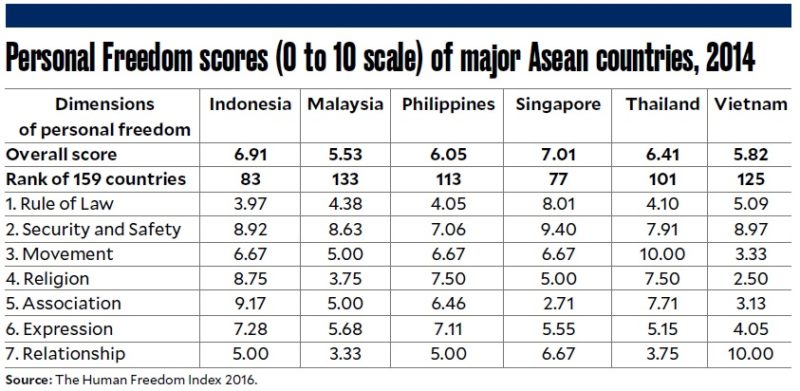The Personal Freedom Index
The latest global compilation of statistics for advocacy to come my way is “The Human Freedom Index 2016” by Ian Vásquez and Tanja Porcnik, published by the CATO Institute, Fraser Institute, and Friedrich Naumann Foundation for Freedom.
The Human Freedom Index merges the Economic Freedom Index and a Personal Freedom Index. The first is an older construction by the Fraser Institute (“The Economic Freedom Index,” Opinion, 11/21/15); the second is my topic today. Both indexes are instrumental to the state of democracy (see “The Democracy Index,” Opinion, 11/15/14).
The Personal Freedom Index (PFI) has seven dimensions, as listed in the table here, with figures for the six major Asean countries as of 2014, the latest available data point. The scores are on a scale from 0 to 10, or the range from no freedom to full freedom; I would read a score of 5.0 as “half-free.”
Article continues after this advertisementThe Philippine PFI of 6.05 in 2014 ranks 113th of the 159 countries that were indexed; the average PFI for all countries is 7.01. Over time, the Philippine score rose at first, but later fell—it was 7.37 in 2008. 7.37 in 2010, 7.77 in 2011, 6.75 in 2012, 5.75 in 2013, and 6.05 in 2014. The world average PFI also fell steadily—it was 7.18 in 2008, 7.13 in 2010, 7.13 in 2011, 7.06 in 2012, 7.04 in 2013, and 7.01 in 2014. These are alarming trends, calling for serious assessment.
Within Asean, as of 2014, the Philippine PFI is in fourth place, behind Singapore, Indonesia and Thailand, and ahead of Vietnam and Malaysia. The Philippines is fifth with respect to Rule of Law, and sixth in Security and Safety; these first two dimensions have half the weight of the PFI. Much of the basic data for these dimensions is from the same sources as the WJP Rule of Law Index (see Opinion, 4/8/17). Other sources are the UN Office on Drugs and Crime, the Uppsala Conflict Data Program, the Economic Intelligence Unit, the CIRI Human Rights Data Project, and the University of Maryland’s Global Terrorism Database.
The other half of the PFI is made up of the scores on the next five dimensions, pertaining to specific freedoms. The Philippines is tied for second, with Indonesia and Singapore, in freedom of Movement. It is second to Indonesia in freedom of Religion. Third in freedom of Association, behind Indonesia and Thailand. Second to Indonesia in freedom of Expression. And tied for third, with Indonesia, in freedom of Relationship, behind Vietnam and Singapore.
Article continues after this advertisementThe scores for the specific freedoms are from many sources, among them the OECD (Organization for Economic Cooperation and Development), the Committee to Protect Journalists, the French Development Agency, Freedom House, and the International Lesbian and Gay Association. What they have in common is advocacy for certain aspects of personal freedom, and an understanding of the role of statistics in pursuing their mission.
Contact mahar.mangahas@sws.org.ph.
(Editor’s note: This has been updated to reflect the Personal Freedom countries of major Asean countries in 2014. Our apologies for the oversight.)

















